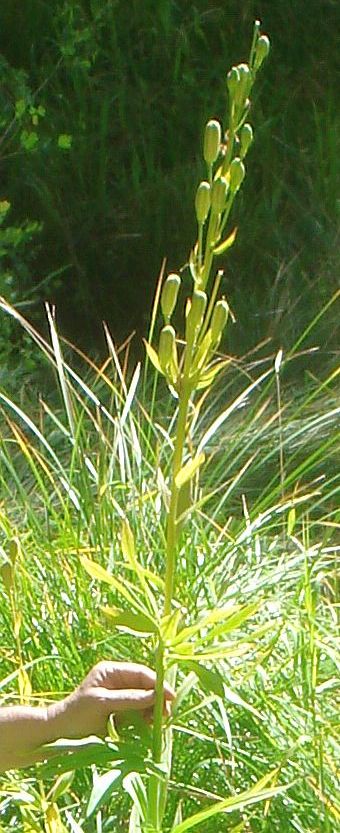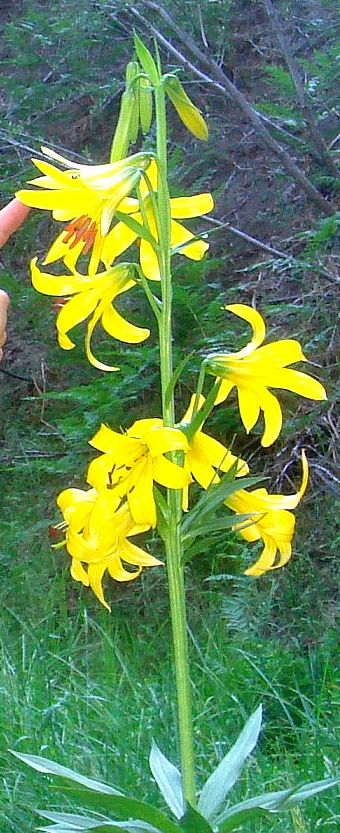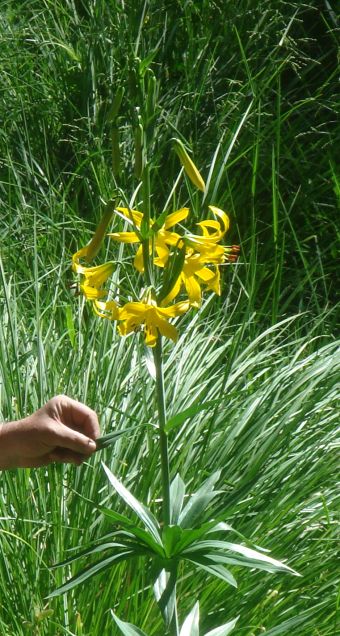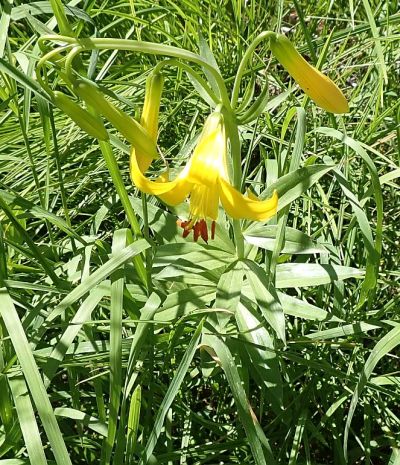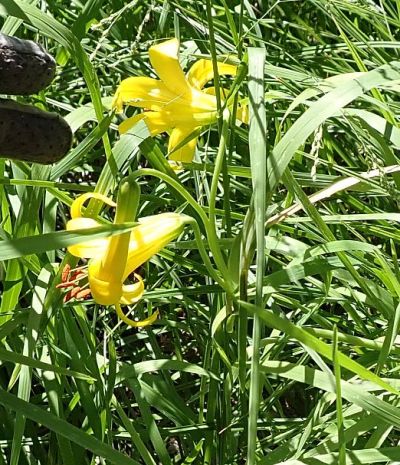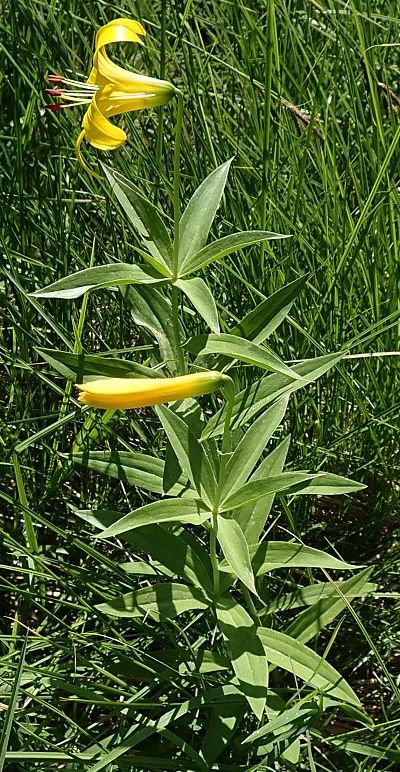The Grandfather Lemon Lily Near Reeds Meadow
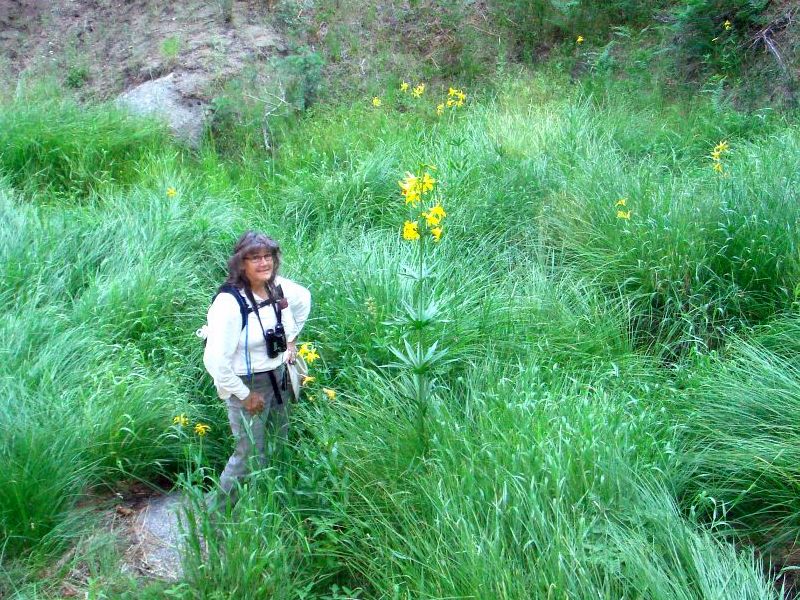
|
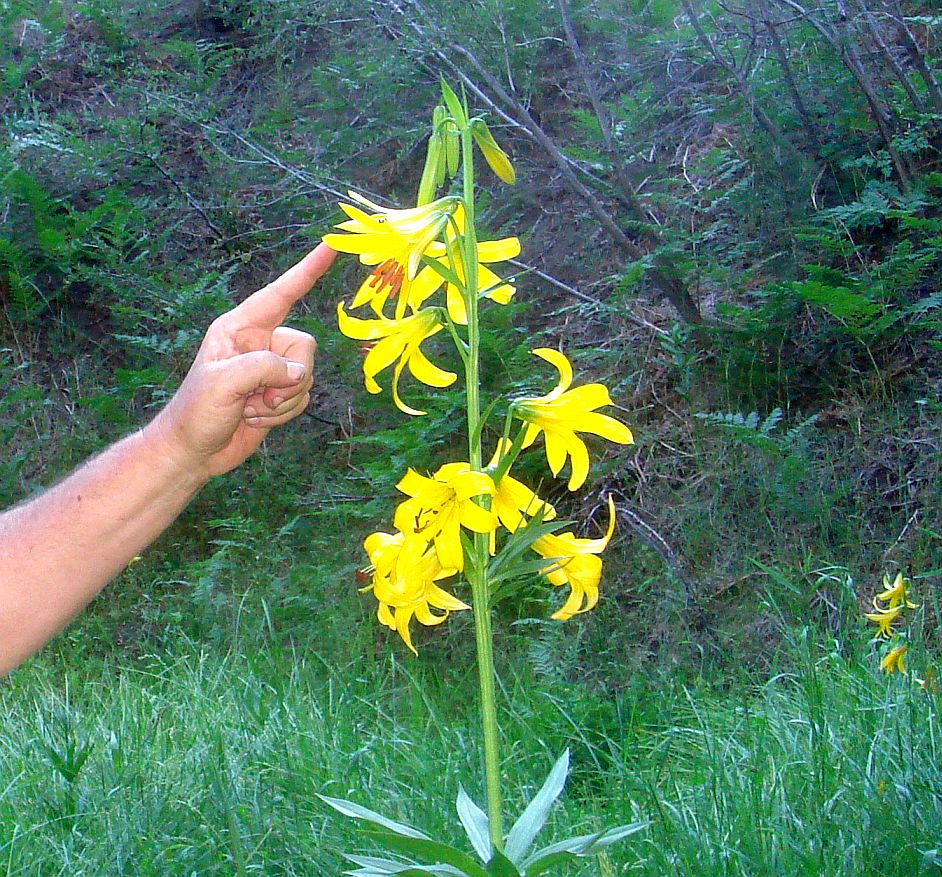
|
| Fig. 1. The Grandfather Lemon Lily at its best on 26 July 2011.
Top: View from the Caramba Trail just past the crossing of Candy's Creek. Pam Pallette is 5 feet tall, and the lily towers over her. Note the other 11 lemon lilies in this picture showing yellow from their flowers. All but two of those other lilies were gone in 2019 and 2021. Bottom: Dave Stith is 6 feet tall, and he has to reach upward to touch one of the flowers near the top of the stalk. See full pix showing Dave and the lily.
|
Table of Contents
Introduction
Bulb Splitting Event
Number of Flowers Vs. Year
Photographs in Time Order
Introduction
We first saw this beautiful tall lemon lily on 29 June 2007 when we passed it on a hike to Caramba. Even then it was a very large lily that stood above all the others in that area, and was probably at least ~ten years old, since older lilies generally produce more flowers as more energy is stored each year in the bulb.
Dave was immediately captivated by this fine specimen. We initially called it the "Candy's Creek Giant Lemon Lily", but Dave eventually renamed it the "Grandfather Lemon Lily" due to its presumed advanced age. We returned to this lily regularly in subsequent years to see how it was doing.
This lemon lily in a small meadowy area along Candy's Creek that is just above Reeds Meadow. It grows inside a large plant of Carex fracta, which protects it from gopher predation.
The Grandfather Lemon Lily has survived a lot of events that could have doomed it. First, it had to somehow germinate even though its seed fell within a large Carex, and not in initial contact with the ground. The seed had to work its way low enough in the Carex to be able to grow roots into the ground. The seedling then had to survive the competition from the dense Carex roots, no easy feat.
The Grandfather survived a near miss from the 2013 Mountain Fire, which burned most of Tahquitz Valley where it lives. It then had to survive the almost simultaneous erosion and deposition that occurred immediately after the fire. Fortunately, only a portion of the watershed of Candy's Creek burned, so it likely that both erosion and deposition of sediment were minimal here. Other nearby areas weren't so lucky; a large number of lemon lilies in lower Willow Creek and lower Tahquitz Creek were wiped out by either erosion or deposition of sediment.
The Grandfather also survived a bulb-splitting event that sometimes leads to the dead of both bulbs.
As of 2021, we have observed this plant over a period of 14 years, which would make its probable minimum age something like 24 years.
If any reader has photographs of this lemon lily prior to 2010, we would appreciate seeing them. This lily is quite visible just downstream from where the Caramba Trail crosses Candy's Creek.
Bulb Splitting Event
Sometime between 2013 and 2019, the Grandfather Lily underwent a bulb-splitting event and transitioned from having a single stalk to have two stalks very close together. We weren't able to pin it down more closely from direct observation of the number of stems since this area was closed to all visitors for a full five years after the August 2013 Mountain Fire, and we weren't able to check on it again until July 2019.
However, it seems likely that the bulb-splitting event was happening in 2013, when the number of flowers had declined from 15 to just 7, and those 7 had abnormal development. Such abnormal development of buds is extremely rare in our extensive observations of lemon lilies.
Despite the six year interval between the last observation of a single stem, and the first observation of a double stem, we are quite confident that we are observing the same plant. Fortunately, the location of the Grandfather Lily is easy to relocate, due to the large flat boulder just a few feet away from the base of its stems; see the top photograph in Fig. 1. Also, since there were nine total flowers observed on the two stalks in 2019, those larger number of flowers had to have come from fairly large bulbs, which would be expected from the split of a very large mother bulb. Finally, the extremely-close spacing of the two stalks is very unusual in the absence of bulb-splitting.
We and others have only observed three other bulbs that have split, and each splitting event had a different outcome; see those outcomes, and a photograph of a cultivated split bulb that produced two nearby stalks (the brownish stuff in between the healthy white scales of the two bulbs is the remnant of the former central part of the bulb pre-splitting).
Fig. 2 shows the two stalks of the Grandfather Lemon Lily on 14 July 2021.
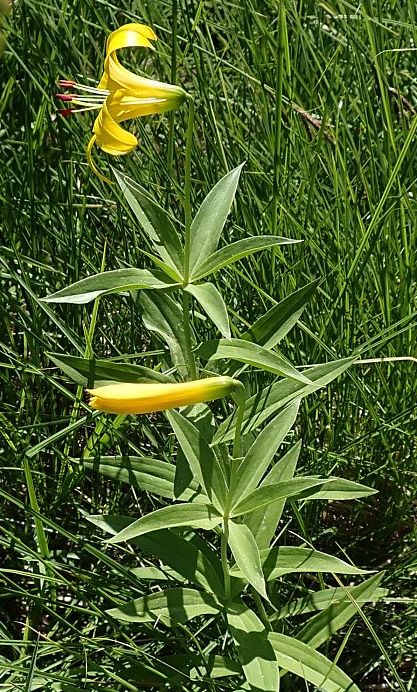
|
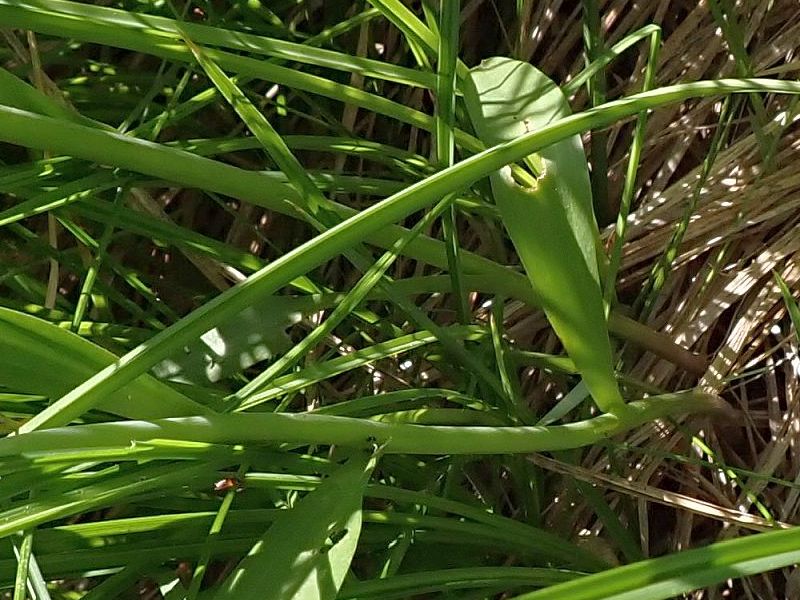
|
| Fig. 2. The two very-nearby stalks of the Grandfather Lemon Lily observed on 14 July 2021.
Top: View of the upper stalks, one with a single open flower and the other with a single bud that is in the process of opening. Bottom: View of the base of stalks, emerging from the ground at extreme right in the photograph. |
Number of Flowers Vs. Year
The number of flowers observed in each year is given in Table 1, along with the number of bloom stalks observed in all of Candy's Creek, which is an indicator of how good the year was for lemon lilies to bloom. A single number is given for the number of flowers when the Grandfather Lemon Lily had a single stalk. Two numbers are given, such as "1 + 1", after it came back as two stalks. If no observations were made in a given year, the table contains "No obs."
It is striking that the total number of blooms on its single stalk declined abruptly in 2013, which may have been caused by the upcoming bulb-splitting event. The Grandfather Lily had its largest number of flowers in 2012, despite the number of lilies blooming in Candy's Creek declining markedly that year.
It is also surprising that this lemon lily, and a few other smaller lilies near it, "took a year off" in 2020. Tom "beat the Carex bushes" thoroughly in that area on 6 August 2020, and no lemon lily plants were present at all, not even ones with short stems. Yet in 2021 the Grandfather lemon lily was back, along with two other lilies in the vicinity.
The 2013 Mountain Fire had a very large impact on the lemon lily population along Willow Creek and Tahquitz Creek in the burn area mostly due to sediment deposition burying lemon lilies and increasing access to the bulbs by gophers. Erosion took out some lilies as well.
We cannot say for sure what happened to the area in which the Grandfather Lemon Lily grows, since we were not allowed into the area for five full years. However, it appears that effects of the Mountain Fire were much less in this area. Most of the area of Candy's Creek was not within the fire perimeter. However, all but two of the 11 other lemon lilies in this area, seen in Fig. 1, are now gone, possibly indicating some at-least-temporary sedimentary deposition that allowed gophers access to those lilies. The Grandfather Lemon Lily is protected from gophers by growing inside a large Carex senta.
Table 1.
| Year | # fls | # CC1 |
|---|---|---|
| 2007 | many | No obs. |
| 2008 | No obs.? | No obs. |
| 2009 | No obs.? | No obs. |
| 2010 | 15 | 214 |
| 2011 | 15 | 170 |
| 2012 | 16 | 38 |
| 2013 | 72 | No obs. |
| 2014 | No obs. | No obs. |
| 2015 | No obs. | No obs. |
| 2016 | No obs. | 178 |
| 2017 | No obs. | No obs. |
| 2018 | No obs. | No obs. |
| 2019 | 6 + 3 | No obs. |
| 2020 | Not present | 50 |
| 2021 | 1 + 1 | 47 |
1This column gives the number of blooming stalks in our quasi-annual survey of the lemon lilies in Candy's Creek. The survey in 2016 was done by Deb Nelson et al.
2The buds had abnormal development, possibly because the bulb was in the process of splitting.
Photographs in Time Order
Fig. 4 shows pictures of the Grandfather lemon lily in time order, with no attempt made to present them at the same scale.
In some years we only observed this lily in fruit. In 2019, after the bulb-splitting, the stems were much shorter and weaker. One stem in 2019 was listing quite a bit and blooming inside the Carex leaves.
